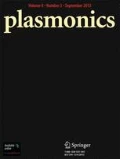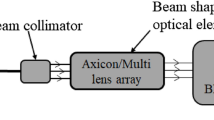Abstract
Plasmonic interaction of nanoparticles located in close proximity, embedded in breast tissue, is simulated for estimating the optical characteristics like optical absorption cross-section, plasmonic wavelength as well as full-width half maxima (FWHM). The computations are done for the monomers, homodimers, and heterodimers of spherical and rod-shaped gold nanoparticles considering various interparticle spacings for gold nanospheres and the interparticle spacing as well as the orientation for gold nanorods (GNRs). The results indicate that for the spherical dimer, with the change in interparticle spacing from 1 to 20 nm, the peak absorption cross-section decreases by 43%. Whereas for the GNRs, the absorption cross-section increases/decreases, within 9–18%, depending on the homodimer or heterodimer configuration. Furthermore, secondary peaks for the absorption cross-section are obtained within wavelengths of 630–940 nm due to antibonding modes for GNR heterodimers. For GNR heterodimer located end-to-end, this secondary peak for the absorption cross-section appears at 780 nm irrespective of interparticle spacing within 1–5 nm. The absorption coefficient is considerably dependent on the configuration and proximity of GNRs located within the tissue. While FWHM is not significantly influenced by GNRs configuration and interparticle spacing. For interparticle spacing from 1 to 20 nm, the plasmonic wavelength shifts by 38 nm for the spherical dimer and by 35–86 nm for various GNR dimers. The findings of this study are useful for plasmonic photothermal therapeutics as the heat generation is governed by the resulting absorption cross-section due to plasmonic coupling of the closely spaced and different orientations of the nanoparticles.



reproduced from published data [15]












Similar content being viewed by others

Code Availability (software application or custom code)
Implemented through COMSOL software.
References
Mieszawska AJ, Mulder WJ, Fayad ZA, Cormode DP (2013) Multifunctional gold nanoparticles for diagnosis and therapy of disease. Mol Pharm 10(3):831–847. https://doi.org/10.1021/mp3005885
Chen H, Shao L, Li Q, Wang J (2013) Gold nanorods and their plasmonic properties. Chem Soc Rev 42(7):2679–2724. https://doi.org/10.1039/C2CS35367A
Gu X, Timchenko V, Heng Yeoh G, Dombrovsky L, Taylor R (2018) The effect of gold nanorods clustering on near-infrared radiation absorption. Appl Sci 8(7):1132. https://doi.org/10.3390/app8071132
Maier SA (2007) Plasmonics: fundamentals and applications. Springer Science & Business Media.
Tali SAS, Zhou W (2019) Multiresonant plasmonics with spatial mode overlap: overview and outlook. Nanophotonics 8(7):1199–1225. https://doi.org/10.1515/nanoph-2019-0088
Zhang M, Qi J, Jiang M, Li Y, Qian J, Chen J, Chen Z, Sun Q, Xu J (2018) Screened bonding, antibonding and charge transfer plasmon modes in conductively connected nanorod heterodimer. J Opt 20(2):025001. https://doi.org/10.1088/2040-8986/aa9f90
Slaughter LS, Wu Y, Willingham BA, Nordlander P, Link S (2010) Effects of symmetry breaking and conductive contact on the plasmon coupling in gold nanorod dimers. ACS Nano 4(8):4657–4666. https://doi.org/10.1021/nn1011144
Funston AM, Novo C, Davis TJ, Mulvaney P (2009) Plasmon coupling of gold nanorods at short distances and in different geometries. Nano Lett 9(4):1651–1658. https://doi.org/10.1021/nl900034v
Manrique-Bedoya S, Abdul-Moqueet M, Lopez P, Gray T, Disiena M, Locker A, Kwee S, Tang L, Hood RL, Feng Y, Large N (2020) Multiphysics modeling of plasmonic photothermal heating effects in gold nanoparticles and nanoparticle arrays. J Phys Chem C 124(31):17172–17182. https://doi.org/10.1021/acs.jpcc.0c02443
Cole JR, Mirin NA, Knight MW, Goodrich GP, Halas NJ (2009) Photothermal efficiencies of nanoshells and nanorods for clinical therapeutic applications. J Phys Chem C 113(28):12090–12094. https://doi.org/10.1021/jp9003592
Davletshin YR, Lombardi A, Cardinal MF, Juve V, Crut A, Maioli P, Liz-Marzan LM, Vallée F, Fatti ND, Kumaradas JC (2012) A quantitative study of the environmental effects on the optical response of gold nanorods. ACS Nano 6(9):8183–8193. https://doi.org/10.1021/nn302869v
Jain PK, Lee KS, El-Sayed IH, El-Sayed MA (2006) Calculated absorption and scattering properties of gold nanoparticles of different size, shape, and composition: applications in biological imaging and biomedicine. J Phys Chem B 110(14):7238–7248. https://doi.org/10.1021/jp057170o
Soni S, Tyagi H, Taylor RA, Kumar A (2013) Role of optical coefficients and healthy tissue-sparing characteristics in gold nanorod-assisted thermal therapy. Int J Hyperth 29(1):87–97. https://doi.org/10.3109/02656736.2012.753162
Ghosh SK, Pal T (2007) Interparticle coupling effect on the surface plasmon resonance of gold nanoparticles: from theory to applications. Chem Rev 107(11):4797–4862. https://doi.org/10.1021/cr0680282
Chen YS, Frey W, Kim S, Homan K, Kruizinga P, Sokolov K, Emelianov S (2010) Enhanced thermal stability of silica-coated gold nanorods for photoacoustic imaging and image-guided therapy. Opt Express 18(9):8867–8878. https://doi.org/10.1364/OE.18.008867
Parsons J, Burrows CP, Sambles JR, Barnes WL (2010) A comparison of techniques used to simulate the scattering of electromagnetic radiation by metallic nanostructures. J Mod Opt 57(5):356–365. https://doi.org/10.1080/09500341003628702
Soni S, Sinha RK (2019) Tumor blood perfusion-based requirement of nanoparticle dose-loadings for plasmonic photothermal therapy. Nanomedicine 14(14):1841–1855. https://doi.org/10.2217/nnm-2018-0494
Brown LV, Sobhani H, Lassiter JB, Nordlander P, Halas NJ (2010) Heterodimers: plasmonic properties of mismatched nanoparticle pairs. ACS Nano 4(2):819–832. https://doi.org/10.1021/nn9017312
Multiphysics COMSOL, Module CMHT (2014) COMSOL multiphysics user’s guide. Version: COMSOL Multiphysics, 3
Johnson PB, Christy RW (1972) Optical constants of the noble metals. Phys Rev B 6(12):4370. https://doi.org/10.1103/PhysRevB.6.4370
Tuchin VV (2015) Tissue optics: light scattering methods and instruments for Medical Diagnosis Society of Photo-Optical Instrumentation Engineers (SPIE), chapter 2
Ash C, Dubec M, Donne K, Bashford T (2017) Effect of wavelength and beam width on penetration in light-tissue interaction using computational methods. Lasers Med Sci 32(8):1909–1918. https://doi.org/10.1007/s10103-017-2317-4
Large N Large group; Widget – Mie Scattering. https://sites.google.com/site/acoustoplasmonics/activites/miewidget; accessed on 04/03/2021
Acknowledgements
Authors acknowledge CSIR-Central Scientific Instruments Organisation, Chandigarh, India, for infrastructure support.
Funding
Vikas received the fellowship from the Indian Council of Medical Research, Delhi, India, vide grant number #5/3/8/83/ITR-F/2020-ITR.
Author information
Authors and Affiliations
Contributions
Vikas and Sanjeev Soni contributed to the study conception and design. Vikas performed the simulation and prepared the first draft of the manuscript. Sanjeev Soni & Raj Kumar edited and reviewed the manuscript.
Corresponding author
Ethics declarations
Conflict of Interest
The authors declare no competing interests.
Additional information
Publisher's Note
Springer Nature remains neutral with regard to jurisdictional claims in published maps and institutional affiliations.
Rights and permissions
About this article
Cite this article
Vikas, Kumar, R. & Soni, S. Investigation of the Plasmonic Interaction of Gold Nanoparticles Toward Plasmonic Photothermal Therapeutics. Plasmonics 17, 107–118 (2022). https://doi.org/10.1007/s11468-021-01506-6
Received:
Accepted:
Published:
Issue Date:
DOI: https://doi.org/10.1007/s11468-021-01506-6



